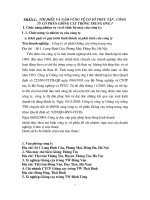AWAREESS I IOVATIVE HIGHWAY COSTRUCTIO I MALAYSIA
Bạn đang xem bản rút gọn của tài liệu. Xem và tải ngay bản đầy đủ của tài liệu tại đây (155.16 KB, 10 trang )
1,2
Lecturer, Civil Eng. Dept, Fac. of Engineering, Universiti Pertahanan Nasional Malaysia, Kem Sungai Besi,
57000 Kuala Lumpur, Malaysia (Tel: +6-03-9051 3400, Fax: +6-03-9051 3472, Email:
2
)
AWAREESS I IOVATIVE HIGHWAY COSTRUCTIO I MALAYSIA
Muhamad Azani Yahya
1
and g Choy Peng
2
ABSTRACT
The need to build new highways and infrastructures, maintain existing roads and preserve
resources has led to innovations in the analytical techniques and technological processes that can
be incorporated in all phases of highway design, construction, maintenance and rehabilitation.
The direction of the argument is to demonstrate that improving construction performance can take a
number of paths. There is an underlying assertion that improving construction performance
need not be the outcome of primarily pursuing procurement solutions. Innovative construction
should produce a quality product which meets capital cost, lifecycle cost and time expectation as
well as client and end user’s satisfaction requirements. These practices can either shorten overall
construction time or make it possible to do work during short term closures especially during off-
peak periods. In Malaysia, the innovative construction concept in highway projects can change
the industry paradigm and improve the efficiency of the construction process. The perceptions
from Malaysian construction players foresee that innovative construction in highway projects is
needed in our local construction sector. This is a pilot study that surveys the awareness of local
construction players regarding to the innovative highway construction.
Keywords: innovative construction, highway construction
ITRODUCTIO
Over the past few years, the construction industry in Malaysia has been overwhelmed by initiatives
and programmes for reform. The direction of the argument is to demonstrate that improving
construction performance can take a number of paths. There is an underlying assertion that
improving construction performance need not be the outcome of primarily pursuing procurement
solutions. A great deal of attention has been given to the drive towards improving construction
performance through procurement and partnering (Cox and Townsend, 1998). It also includes
innovative construction. Innovation in construction can be spearheaded by occur through
research and development in construction materials, methods, equipment, new design concepts,
just in time methods in procurement integrated project management, project delivery system and
available readymade products (Aboobucker, 2009).
Highway sector is categorized as one of the most conservative segment of the construction
industry in Malaysia. However, there have been a number of significant changes in recent years
for the highway projects, such as the implementation of innovations in highway construction. It
has been very challenging for engineers, contractors as well as client to implement and practice
innovations in highway projects. The aging of the road infrastructures and the increases in traffic
volumes have pushed the transportation sector to build more efficient highways in recent years.
Therefore, there is a need to develop innovative and rapid highway construction method due to
societal demands of high quality roads to be put in place as quickly as possible (Beceric, 2005;
FEHRL, 2008). Besides, the highway maintenance and rehabilitation has to be fast to save time
and money as well as to increase the safety of workers, road users and the public. In order to
accomplish this, the mind sets of the construction players have to pursue innovative in
construction methods that would allow the work to be completed in a quality manner and in a
2
timeframe that will have a minimal impact on the travelling public.
The main difference between conventional and innovative highway construction is as shown in
the following figure. Generally, conventional construction approach use control and mechanism
to execute the construction task meanwhile in innovative construction approach, the innovative
method is use and at the same time, the construction players gain knowledge and learns in
executing the construction task.
Control
Knowledge
Gain/ Learn
Input
Construction
Task
Output
Input
Construction
Task
Output
Mechanism
Innovative
Method
Conventional Approach Innovative Approach
Figure 1: Conventional and Innovative Approach in Construction
There are many advantages to use innovative construction methods in highway projects. By
reducing construction time, the fast track innovative methods minimize delays, mitigate
congestion, save money for the transportation agencies and the road users, and improve the
safety of the motorists and the workers, without sacrificing the quality. Since significant costs
are imposed on the public during highway construction, including driver delay and disruption
to local businesses; as a result, political and public pressures mount for highway construction
projects to become more efficient and require less time to complete.
While pressures to expedite highway construction increase, the public also reasonably expects
high quality new roads to withstand decades of highway activity. Innovative construction methods
provide a significant opportunity to reduce the congestion associated with the highway projects.
These methods will lessen project durations while retaining the necessary quality.
Opportunities for innovative methods are numerous. For example, pre-cast or modularization,
alternative contracting strategies, and project incentives have shown that alternative methods can
work. Although it may be uncertain which method to utilize on a specific project, some
methods are immediately employable on many projects.
Objective of the Study
The objective of this study is to identify the awareness of the construction players in Malaysia
about innovations in highway construction and suggest the innovation construction method that
can be implemented for the highway project in Malaysia. As there have been innovations within
the highway construction industry, the authors wanted to gain insight into what construction
professional felt about the issue of innovation. The study sought specific opinion about current
state of innovation within the highway construction industry.
3
IOVATIVE HIGHWAY COSTRUCTIO
Innovative construction is defined as construction involves the use of special materials or
methods (Montana Department of Transportation, 2009). By all means, innovative construction
should produce a quality product which meets capital cost, life cycle cost and time expectation as
well as client satisfaction requirements. Innovative construction is due to market driven
innovation (Rontakokko, 2007). It is a new process with a new organizational structure to create
a new concept for success in the market. As this is a rapidly evolving area, newly emerging
techniques and materials must continuously been develop. As mention before, in highway
construction, innovations in construction involve the use of special materials or techniques that
reduce construction time, saving costs, minimize or mitigate the effect of traffic congestion and
increase safety.
There are many advantages from innovative highway construction which includes expediting
construction and reconstruction project as many innovations are proven successful worldwide.
The advantages from awareness in innovative highway construction can improve many aspects
such as meeting road users’ requirement, optimum life cycle and operational costs, eliminate
waste in project, better management in supply chain, develop learning cultures in projects, create
better health and safety records and move away from adversarial approaches between the
industry and client.
Although it may be uncertain which innovative method to utilize on a specific highway project,
some methods (Federal Highway Administration, 2010) can be implemented as an innovative
construction includes, construction analysis for pavement rehabilitation strategies, design-build
contracts, full road closure, high-performance steel bridges, innovative contracting, intelligent
compaction, intelligent transportation systems, light weight deflectometer, movable barriers in
work zones, prefabricated bridge elements and systems, precast concrete pavement systems, self-
consolidating concrete, silica fume in high-performance concrete, self-propelled modular
transporters, whitetopping and work zone safety and traffic flow initiatives.
Generally, innovations in highway construction can be categorized to 12 categories (Goodrum et.
al, 2005), automation equipment/ construction technology, information technology, innovative
contracting, innovative field methods, innovative management, innovative materials, innovative
planning and design phase, innovative software/ databases, innovative financing, public
awareness/ increased awareness, relocation of utilities and work zone traffic control. However,
the authors felt that innovations in highway construction can be categorized into 4 major
categories, which is innovative in planning and design, innovative in contracting, innovative in
construction management and innovative in construction materials and technology.
Innovative in Planning and Design
Innovative in planning and design including establishing utility corridors and systematically
locates the facilities prior before the construction, use comprehensive standard tools to
standardize planning, develop traffic control plans through partnering with the transport
department and file organization, use windowed milestone and etc. Besides, innovation in
planning and design including employing engineers with experience both in highway design and
highway construction as this may benefits the highway construction project as designers with the
ability to think like contractors can help to speed up the projects and they will have the ability to
4
analyze the project constraints and resources.
Innovative in Contracting
The traditional approach to contracting for highway construction projects has been design-bid-
build (Hancher, 2000). Under this approach, projects are awarded to the qualified bidder with the
lowest total price, pay items are established on a unit price basis, the specifications for highway
projects are strict method specifications, and the role of the owner or agent is to inspect. Under
innovative in contracting, team concept is establish whereby the right of way, utility and design
team should coordinate issues and needs as early as possible and limit the number of people
contacting with the property owner and frequently coordinate, cooperate and communicate
between each party. New contract such as design-build with bridging, turnkey, warranty,
maintain, privatization approaches shall be adopted. Besides, a big project can be packaged into
multi-primes approach to contracting in order to expedite the construction process.
Innovative in Construction Management
Innovative in construction management include designated a single individual as project
manager from early planning to completion of the highway construction, packaged multi-primes
approach to contracting, exploit web-based team collaboration and project management system,
use of windowed milestone, use pilot demonstration project for introducing new methods for
expediting schedules, train selected field personnel in scheduling methods and claims and study
optimal approaches to crew shifts and scheduling.
Innovative in Construction Materials and Technology
Innovation in construction materials including selection of appropriate pavement materials such
as using quick curing concrete, in-place recycling, precast components, geosynthetic-reinforced
or piled supported earth platforms for embankments, retaining walls and storage tanks
constructed on soft soils and etc. Geosynthetic or pile supported earth platforms for embankment
on soft soils is consider as the most frequent innovative construction materials in soil
strengthening (Goodrum et. al, 2005). Other innovative field methods are using pre-stressed
concrete panels for expediting pavement construction, compaction using automatic vibration
control system, micro sensor for perform faster inspection and minimize field fabrication effort.
Conventional ground improvement method such as stabilization with lime, cement or
combination of lime and cement are quite popular in highway construction. However, the
constraints of this method are problem associated in attaining homogeneity of soil stabilizer mix
in the field. Besides, the stabilization techniques needs appropriate training and capacity building
of field engineers. Under innovative construction, ground improvement can be carry out by using
waste material such as rice husk ash, fly ash and etc. Many studies have shown that the use of
waste material has great impact in soil stabilization especially in clayey soil (Madhavi et.al.,
2006) as these waste materials can improve the Atterberg limits and increase the unconfined
compressive strength.
Innovation in ground improvement also includes the use of soil stabilization enzymes such as
Fujibeton (inorganic polymer), Terrazyme (bio-enzyme product) and Renolith (polymer based
chemical). Use of these products can minimize or eliminate the use of aggregates. The use of jute
geo-textile can strengthens the soil subgrade as it act as a separation layer between subgrade and
5
subbase and prevent intermixing of the two layers. It also prevents migration of fines to the
subgrade. A study in India has shown that the use of jute geo-textile can save 12% (Madhavi
et.al., 2006) of road construction cost. Soil stabilization using polymer such as nanostab can
reduce the construction duration as well as reducing the emission of carbon dioxides during the
construction period as compared to conventional method.
Innovation in construction technology include carried out maturity testing, perform faster
inspection and construction monitoring, use automated construction technology such as GPS, use
of innovative paver, computer integrated road compactor, onboard compacting meter, automatic
vibration control system and etc.
METHODOLOGY
Since this is a pilot study on the awareness of the construction players about innovations in
highway construction in Malaysia, the survey was conducted using the web-base questionnaires.
Respondents were asked general demographic questions regarding their employment status, their
professional within the industry in order to diversity the sample within the construction industry.
A total of 135 emails were sent to those with civil engineering background, especially those who
involves in the highway construction industry. Besides, a link of the survey questionnaires was
also published in facebook to obtain some opinions from the general public. There are 5 basic
questions in the questionnaires that seek the opinions of the respondents about the innovative
highway construction and only completed and filtered responses were analyzed in this study.
FIDIGS
A total of 35 respondents’ opinions were taken in this pilot study whereby these respondents
have completed all the questionnaires. 91% of the respondents are employed and 9% of them are
self-employed. The respondents serves in various sectors, which includes construction (23%),
consultancy (28%), surveying (3%), education (26%), engineering (6%), research and
development (6%) and others (8%). Others sectors includes sales and property development. The
followings table shows the profession of the respondent.
Table 2: Respondents’ Profession
Profession Number
Profession Number
Project Director 0 Supervisor 3
Project Manager 5 Lab technician 0
Lead Engineer 0 Surveyor 1
Design Engineer 4 Contract Manager 1
Assistant Engineer 1 Architect 0
Chief Resident Engineer 1 Lecturer 9
Resident Engineer 1 Researcher 0
Assistant Resident Engineer 2
Other
(Student/ Sales Executive)
4
Clerk of Work 3
The authors believed that the main driver of innovation in highway construction includes cost
efficiency, sustainability, client’s demands, time constraints, technology, health and safety,
legislation, environment, global competition and end user. The following table shows the







